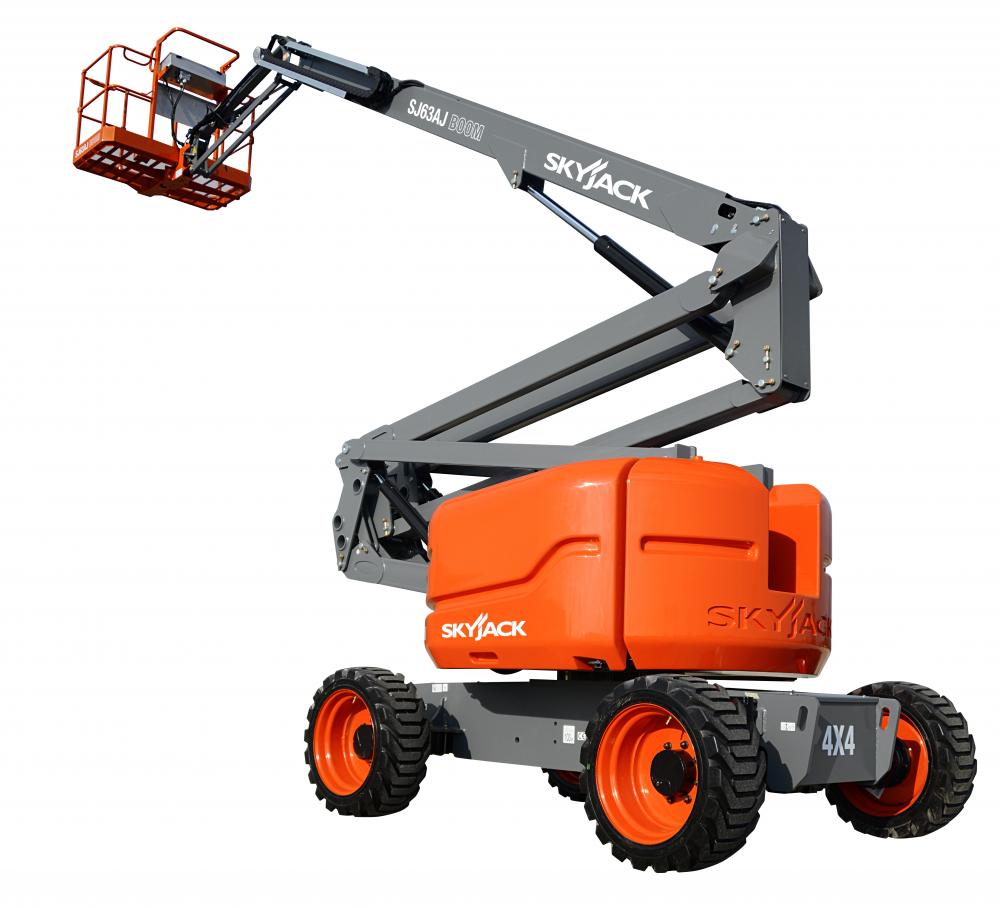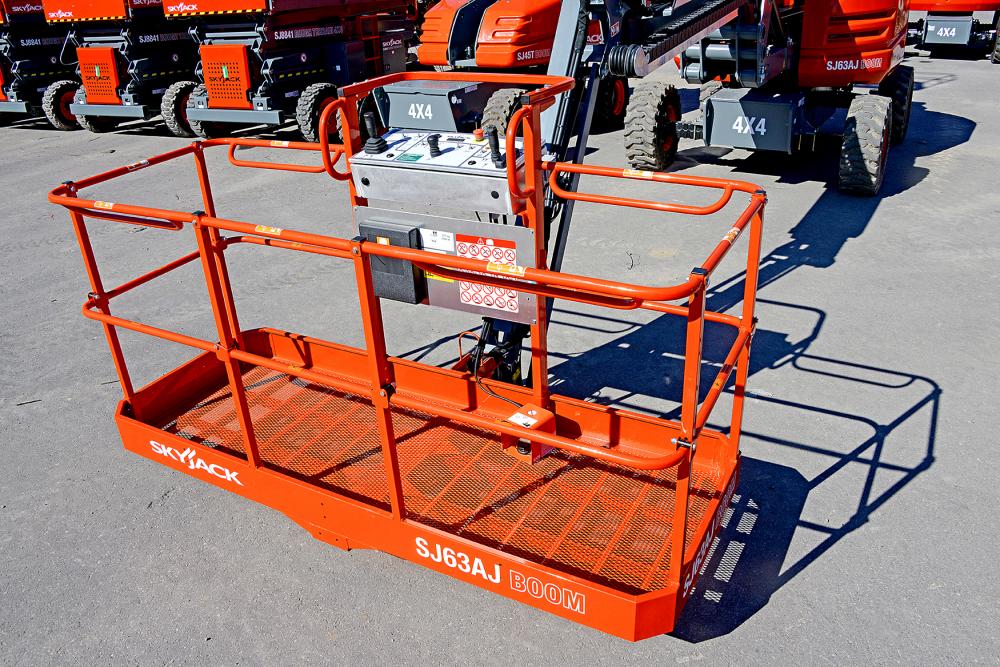Guelph, Ontario-based Skyjack is back with its second articulating boom lift for the North American market. The 63'7" platform height SJ63 AJ provides a modern take on a classic four-wheel-drive machine. This popular boom lift size can be found on many construction and industrial sites, equipped with a diesel or dual-fuel engine and tires that match the machine to the site. The cost-saving and productivity features and benefits of this machine give many others in this product class a run for their money.
The standard four-cylinder, 65-hp Deutz D2011 L40i diesel engine is located underneath a fiberglass cowling. Skyjack uses reinforced fiberglass because it costs less than laminate cowlings and provides more rigidity on rough-terrain sites.
According to Paul Kreutzwiser, Skyjack’s senior product manager, using fiberglass will keep rental companies out of the difficult position of having to ask customers for a couple thousand dollars to replace the cowling if it becomes damaged. With Bondo filler, sanding, and some elbow grease, the cowling can be quickly repaired. “You’ll find those types of features throughout the machine—where we design it with the intent of it being a rental asset,” he adds.
On this unit, Skyjack employed Eaton piston pumps for drive and system functions. “We use a piston pump rather than a gear pump because we are able to get a little more functionality and on-demand pressure and flow from the system,”
Kreutzwiser says. “That translates to a much smoother, easier-to- predict ride for the operator.” This is the first time the company is using Eaton pumps, but Kreutzwiser says they will likely use more pumps from Eaton to keep components common throughout the boom lift product line.
All service components are on the outboard side of the machine; however, if a service technician needs to work on the starter or exhaust manifold, the engine tray swings out for easy access to the back of the engine. An optional 82-hp GM Vortec 3L dual-fuel engine is available, and all service components are located on the same side, so it has the same fit and bolts as the diesel engine. The alternator is accessible with this model when the engine tray is opened. The battery is also an easy-to-reach service component.
On the other side, there is a 30-gallon fuel tank for the diesel fuel and a 30-gallon hydraulic fluid tank. Skyjack uses a steel hydraulic tank for durability, as well as to allow the hydraulic system to dissipate heat more naturally than a poly tank. All valves and components are accessible for service. “Our goal when designing and laying out the system is that you can get a wrench on any fitting that’s in here, so we do that for that specific reason,” Kreutzwiser says. “Nothing is hidden or behind another component that needs to be taken off to be serviced, so you will be able to access everything.” For example, a grease fitting next to the lower control box makes it easy for the operator to grease the ring gear.
The main manifold uses the Skyjack color-coded and numbered wiring system. This system has been employed on every Skyjack machine made since 1985, using the same color and number codes for common functions like lift and lower, regardless of whether the machine is a scissor lift, mast lift, or boom lift.
The lower control box is analog-based, so you won’t find a black box or computer providing the control logic and driving the valves. Instead, the hard-wired controls use the colored and numbered wiring system and automotive-style relays.
These relays are non-proprietary and can be found at an automotive supply store when they need to be replaced.
Skyjack’s relay system also makes troubleshooting easy. For example, if the lift function is not working, the relay can be looked at first—if it’s not clicking, then you know the malfunction is the relay and it needs to be replaced.
Drive and steer
The SJ63 AJ uses the same axle-based drive system as other Skyjack boom lifts. The Dana axles are commonly used on telehandlers and front-end loaders. The front axle is the same as on the SJ66T telescopic boom lift, and the rear axle is shared with the SJ46 AJ.
The rear axle has an operator-controlled differential lock. In normal situations, the machine will be four-wheel drive and will have an open differential in the rear and limited-slip differential in the front. A switch on the control box lets the operator lock the rear axle if the machine starts to lose traction, as in mud or sand. When locked, the axle provides 100% power to both wheels.
Tire options include foam- or air-filled, non-marking tires, grip lug-type tires, and flotation or sand tires, which are good for operating in fine or loose materials.
Two holes on the chassis allow the boom to be locked straight when being transported and offset slightly, allowing two of these lifts to fit on a truck. Even with the heaviest combination of options on this machine, such as foam-filled tires and the welder/generator package, the machine will weigh about 22,000 lbs., keeping two of them under the 45,000-lb. gross weight load limit for most flatbed trucks.
Booming achievements
The riser geometry is unique on the SJ63 AJ. When the riser goes straight up and down, the back pivot point for the main boom will stay on a perfectly vertical plane, allowing true vertical rise. The platform will move straight up and down like a scissor lift, giving the operator more predictability when inside a plant or along the façade of a building.
“You’re going to be able to go from one story at one window up or down without having to reposition the jib or main boom,” says Kreutzwiser, adding that it takes out the guesswork for operators. The articulating boom features the open-center knuckle riser design, which allows the main boom to get into a below-horizontal reach position. The riser is split into two sections, and two lift cylinders are used for the riser functions to provide a more rigid feeling by stacking the riser components and achieving a more compact design. In the below-horizontal position, the lift operates like a telescopic boom lift, going from the ground to full height only using the main boom function.
Control central
Like other Skyjack boom lifts, the SJ63 AJ has a modular steel platform so that individual sections can be unbolted and replaced if the platform is damaged. The standard platform is 8 ft. wide with three drop-bar entrances. A 230-lb. capacity pipe rack, a 3,500-watt hydraulic generator, a welder package, a glazier package attached to the front kick plate, and swing-open entrance gates are optional equipment.
Controls are common among all articulating booms with the riser function. All Skyjack boom lifts incorporate direction-sensing drive-and-steer control, which means the controls are always oriented with the operator—even when the turret is rotated out of the normal front position.
The control box uses simple toggle switches that are easy to replace if damaged and easy to use, even when wearing gloves. The metal platform control box can be disconnected by unscrewing four bolts and disconnecting the main connections.
The SJ63 AJ from Skyjack has been designed to be an asset for rental companies and end users, with productivity and serviceability features that lead the machine in that direction.

